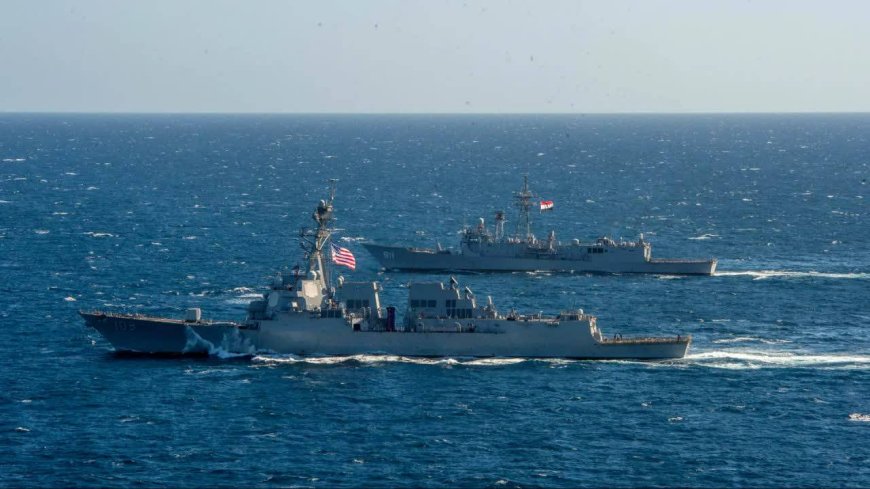The US Navy Sets its Sights on the Red Sea: Unveiling Uncle Sam's New Destabilizing Agenda in the Middle East
The US Navy Sets its Sights on the Red Sea: Unveiling Uncle Sam's New Destabilizing Agenda in the Middle East

The Red Sea region has seen a significant power shift with the recent deployment of over three thousand personnel by the US Navy's Fifth Fleet. This move raises questions about the implications of this military action and its impact on the region. In this article, we delve into the details to decipher the motives behind the US strategic moves in Yemen and shed light on the potential consequences.
The deployment of American forces, including the aircraft carriers USS Bataan and USS Carter Hall, in the Red Sea marks a significant development. These naval assets enhance the maritime capabilities and flexibility of the US Navy's Fifth Fleet. The USS Bataan, an amphibious assault ship, carries fixed-wing and rotary-wing aircraft, as well as amphibious frigates. Meanwhile, the USS Carter Hall serves as a landing craft, facilitating the transportation of Marines and their equipment for onshore operations. This robust presence raises eyebrows and demands a closer examination of the underlying motivations.
Yemen's Watchful Eye: The Yemeni Navy's Response to American Intrusion
The Yemeni Navy has been closely monitoring the passage of American forces in international waters within the Red Sea. In response, they have positioned maritime surveillance boats and ships two miles away from the international shipping corridor to monitor any potential intrusion by the US into Yemeni territorial waters. The Yemeni Navy conducts extensive patrols within the areas controlled by the "Ansarullah" movement, encompassing 18 islands in the Red Sea, to closely monitor any hostile movements. Major General Mohammad Al-Qadri, the commander of the Coastal Defence Force, emphasizes Yemen's readiness to respond and prevent any encroachment on its territorial waters. This tense situation highlights the potential for a naval showdown in the Red Sea.
Mukalla: The Key to Controlling the Red Sea
US forces have significantly strengthened their presence in the strategically important city of Mukalla. Regular patrols along the international shipping route in the Red Sea and Bab al-Mandeb, along with frequent travel between Mukalla and the American naval base in Djibouti, demonstrate the US's focus on controlling this corridor. Of particular interest is the large island of Al-Hanish, where the US has established a ship tracking center and a naval operations room. Mukalla's significance cannot be understated, as it serves as a crucial vantage point for the US to assert its influence over the Red Sea corridor.
Unraveling Motivations: Why is the US Increasing its Presence in the Red Sea?
The question that arises is why the United States has chosen to increase its forces in the Red Sea at this particular time. While various parties involved in the Yemeni conflict seemingly desire to end the war, the US does not appear eager to conclude the conflict. Despite initial claims of seeking to end the devastating war in Yemen, the US has shown reluctance to take concrete steps in this regard. Yemeni officials, including Mehdi Al-Mashat, head of the Supreme Political Council of Yemen, have repeatedly emphasized that the United States is obstructing peace talks and the official conclusion of the war in Yemen. This raises suspicions about the true motivations behind the increased American presence.
Diplomatic Gambits: Can Talks Bring Peace to Yemen's War-Torn Shores?
Alongside military activities, the US has also engaged in diplomatic initiatives. Tim Lenderking, the special envoy for Yemen affairs, is visiting the Persian Gulf to facilitate a ceasefire and initiate a comprehensive peace process. His discussions with Yemeni, Saudi, Emirati, Omani, and international counterparts aim to find a sustainable ceasefire, commence an inclusive political process under the United Nations' mediation, and alleviate the economic crisis and suffering in Yemen. However, Lenderking's previous pessimistic statements about the negotiations indicate that achieving a lasting solution to the conflict will not be easy.
In conclusion, the escalation of American military presence in the Red Sea has significant implications for the Yemeni conflict and the region as a whole. The motives behind this deployment, the response of the Yemeni Navy, the strategic importance of Mukalla, and the ongoing diplomatic initiatives shape the complex dynamics of the situation in the near future.













































